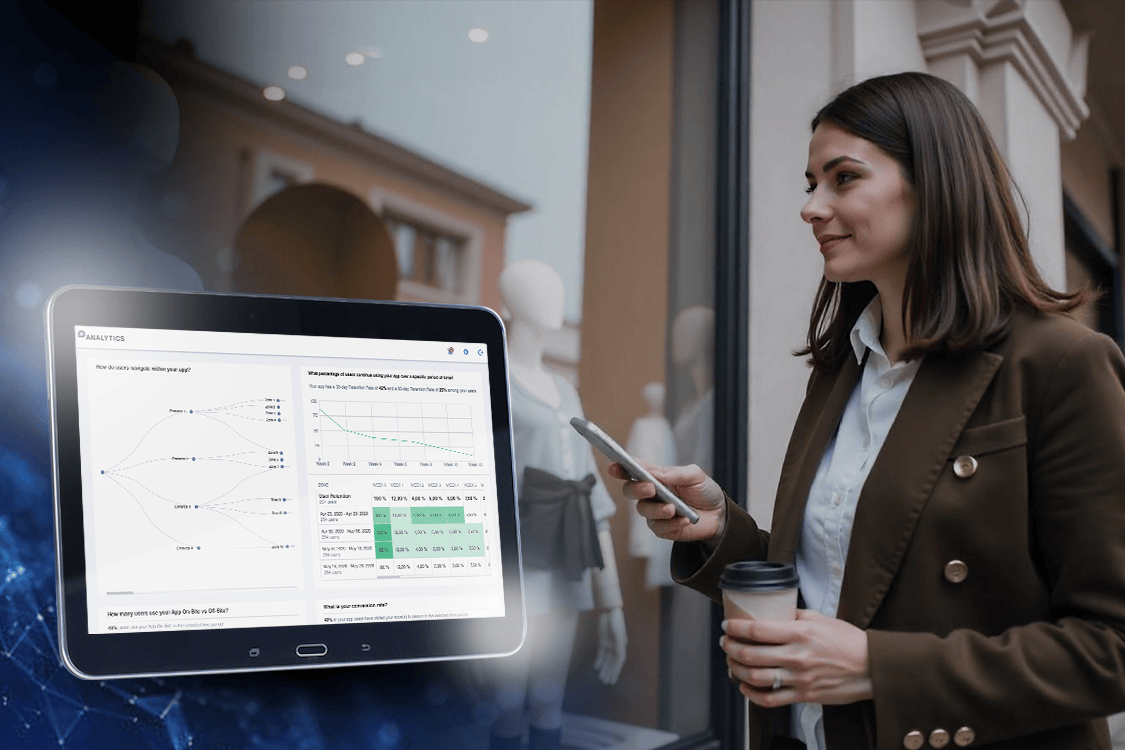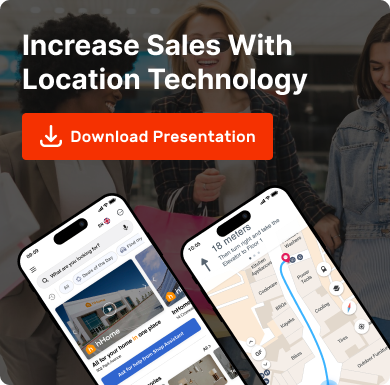Big Box Retail & Malls

Have you ever walked past a store and your phone buzzed with a sale alert? That’s hyperlocal marketing in action. By blending AI, location-based data and geo-targeting, brands deliver perfectly timed, highly relevant promotions — right when you’re most likely to act.
In this blog, we break down how hyperlocal marketing evolved, how AI and predictive analytics are changing the game and why minimal hardware solutions like Mapsted are the future of indoor targeting.
According to recent reports:
- Nearly 90% of marketers say location-based campaigns drive higher sales.
- 84% report increased customer engagement.
- 94% plan to scale their location-targeted efforts.


In this blog, we break down how hyperlocal marketing evolved, how AI and predictive analytics are changing the game and why minimal hardware solutions like Mapsted are the future of indoor targeting.

The Growth of Hyperlocal Marketing
“Local marketing” used to mean Yellow Pages and radio spots. Then came “near me” Google searches. The real shift happened with smartphones. Brands began using GPS to build geofences—virtual boundaries around stores, malls or events—and trigger location-specific ads.
Then came beacons: tiny Bluetooth devices placed inside stores that detect smartphone proximity and send in-the-moment offers. For example, Rite Aid deployed beacons across 4,500+ stores to deliver aisle-specific offers. But hardware-heavy solutions like beacons can be expensive and hard to manage at scale.

Why Hyperlocal Marketing Matters
Let’s be honest — nobody wants irrelevant ads anymore. Here’s why marketers are leaning into hyperlocal marketing:
- Timely Offers: A coffee coupon matters more when you’re outside a café at 8 a.m.
- Higher Engagement: 75% of marketers say location-based targeting improves customer interaction.
- Better ROI: 67% say precise targeting is the biggest benefit; over half of them use location to personalize experiences.
- Opt-in Willingness: 90% of consumers are open to sharing location data for deals or convenience.
Knowing where and when to reach a customer increases conversion and loyalty.
AI in Marketing: Supercharging Geo-Targeting and Predictive Analytics
Even the best geofences only tell you where a customer is. AI helps you understand who they are, what they like and when to engage. That’s where things get powerful.
Micro-Segmentation & Hyper-Personalization
AI models break users into ultra-specific segments—not just “gym-goers” or “students,” but “weekday morning joggers who order protein bars.” This allows businesses to trigger the right message at the right time.
Swiggy nailed this during Coldplay’s 2024 tour. They pushed real-time notifications with witty, mood-based snack offers—blending timing, behaviour and relevance.

Contextual Content & Timing
AI tracks more than just location. It considers weather, traffic, crowd density and events. Raining outside? Expect a nudge for hot beverages. In a packed mall? Get guided to less crowded stores or trending items.
Automated Bidding & Predictive Analytics
AI doesn’t just respond; it predicts. Platforms adjust ad bids based on real-time foot traffic. If a stadium event is about to end, marketers can pre-schedule campaigns to capture post-game footfall.
Combining predictive analytics with geo-targeting leads to smarter planning, tighter budgets and higher conversion.
Location Data & the Power of Personalization
Hyperlocal marketing thrives in real-world contexts. Here’s how:
- Geofencing: Send welcome messages when visitors enter a mall or venue.
- On-Site Engagement: Highlight offers near the product aisle, museum wing or gift shop a visitor is browsing.
- Behaviour-Based Targeting: A vegan food brand can target regulars of plant-based cafes in a specific block.
As long as brands offer value and stay transparent, consumers welcome the personalization.
Real Brands, Real Impact
Deliveroo
To scale personalized ads, Deliveroo automated local details like restaurant names and unique codes into geo-targeted creatives. Result? 30% more impressions in high-priority zones and stronger engagement.
Rite Aid
Using beacon-based proximity marketing, Rite Aid sent push notifications tied to store sections—like a bandage coupon in the first-aid aisle. Despite the heavy hardware setup, it significantly boosted in-store conversions.
Minimal Hardware Location Intelligence: The Next Big Thing
Platforms like Mapsted are changing the game with hardware-free positioning. Using smartphone sensors (accelerometer, magnetometer, etc.) and AI-driven algorithms, brands can:
- Save costs by ditching beacon installations.
- Seamlessly track users indoors and outdoors.
- Scale faster with back-end updates instead of physical device tweaks.
- Gain insights with sensor fusion and predictive analytics.
Industries from retail and tourism to healthcare and education are adopting this for better engagement and streamlined operations.

Key Takeaways
- Personalization Is the New Baseline
77% of consumers expect brands to speak to them directly and in real-time. If you’re not personalizing — especially locally—you’re already behind.
- AI Isn’t Just Smart, It’s Strategic
Predictive analytics help you know when and where to show up. Whether it’s foot traffic spikes or local trends, AI lets you plan smarter, not harder.
- Hardware-Free = Hassle-Free
Software-only solutions like Mapsted mean no beacon batteries, no physical updates — just clean, cost-effective targeting that works across large venues and complex spaces.
- Privacy Isn’t a Barrier — It’s an Invitation
Nearly 90% of consumers say they’ll share their location for something valuable in return. The trick? Respect, transparency and relevance. If you get that right, trust follows.
Conclusion
In the end, hyperlocal marketing isn’t just about signals and sensors — it’s about serendipity with intent. A shopper gets a discount just as they pass your store. A tired museum-goer is guided to the nearest café. A concert fan gets a snack suggestion that feels like the app just gets them.
That’s not an algorithm talking. That’s good timing, powered by great data. AI, predictive analytics and hardware-free platforms like Mapsted don’t just make this possible — they make it scalable.
And in a world of short attention spans and constant swipes, showing up with the right message, at the right place, in the right mood — that’s not just good marketing. It’s the only marketing that truly works. If you found this blog helpful, don’t miss our post on What is Retail Space Planning & Planogram? Mapping CX in Retail Shopping Malls and Large Venues or watch our video on Smart Retail Navigation Solutions for Big Box Stores to learn more.
Frequently Asked Questions
Q1. What is hyperlocal marketing and how does it work?
Ans. Hyperlocal marketing targets customers in specific areas—like neighbourhoods, stores or even aisles—using real-time location data to deliver personalized messages or deals.
Q2. How does AI improve hyperlocal marketing?
Ans. AI enhances personalization by analyzing patterns, behaviours and context (weather, traffic, events) to deliver timely, relevant content.
Q3. What’s the difference between geo-targeting and geotargeting marketing?
Ans. Both geo-targeting and geotargeting marketing deliver content or ads based on a user’s location. Advertising and digital campaign location-based targeting strategies are often used interchangeably.
Q4. Can hyperlocal marketing be used indoors, like in malls or hospitals?
Ans. Yes, and that’s where it becomes even more powerful. With minimal hardware platforms like Mapsted let companies aim users exactly inside big venues, providing turn-by-turn navigation, store-specific deals or real-time updates all without beacons or GPS.
Q5. What are some real-world examples of hyperlocal marketing success?
Ans. Yes, Deliveroo increased impressions by 30% using local ad variations. Rite Aid boosted conversions by using beacons for in-store targeting. Swiggy timed snack alerts during a Coldplay concert tour—smart, contextual and memorable.

